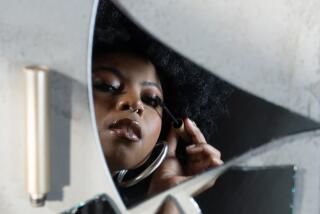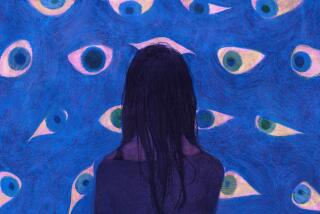Eye of the Beholder
- Share via
As a little girl she’d gaze at herself over and over in the mirror. Something was different about her face, that much Pamela Brew knew. What exactly, however, eluded her. She scoured beauty magazines and played with makeup, searching again in the mirror and trying to decipher the cosmetics secrets of the models in the pictures.
“Finally I figured it out--why I could never do the same things,” recalls Brew, 36, a fourth-generation Chinese Japanese American. “Finally I pinpointed it: ‘Oh, I don’t have this crease across my eyes.’ ”
By 10, she was determined to get one. More than two decades later Brew realized her childhood dream when Dr. Ronald S. Matsunaga, a Beverly Hills plastic surgeon, gave her what only 15% of Asians are born with: double eyelids, or a crease between the brow and lashes.
“I feel I’m a lot more attractive now,” says Brew, a project manger at Mattel Toys who used to handle Barbie and today labors in the Cabbage Patch.
“I don’t have to second-guess where my eye shadow goes--something a Western person would take for granted. I wanted big and beautiful Caucasian eyes, like the models. Having a fold creates a world of difference.”
“Westernizing” eyes has long been a popular practice throughout Asia. The standard method is Bookoochai, named after the Singaporean physician Boo Koo Chai, who developed it more than 30 years ago in the cultural wake of the American occupation of Japan and the Korean War. Stitches passed along the length of the eyelid form a scar that creates a false supratarsal fold. On this rim of the Pacific, however, doctors have been developing more refined techniques with more durable results.
During a typical operation, the surgeon makes an incision in the eyelid where the fold will go, removes fat from the lid, stretches its skin and reconfigures the muscles that lift it. It takes about an hour for each lid. The swelling, though, may take six months to completely subside.
“We can take an Asian patient and with only double eyelid surgery make her look Eurasian,” says Matsunaga, who charges about $3,500 for the procedure, which constitutes nearly half of his practice.
These days, plastic surgeons such as Matsunaga and Dr. Andrew Choi in Koreatown are performing more surgeries than ever--about five a week for Matsunaga and up to seven a day for Choi during his busy season when high schools and colleges are closed. (Most of the patients who undergo the procedure are women.)
Matsunaga, who in November presented a paper describing his technique to a national seminar on the latest advances in plastic surgery, says surgeons from such unlikely places as Georgia and Tennessee have been asking about Asian eyelid surgery. And the spring 1996 issue of the American Academy of Facial Plastic and Reconstructive Surgery’s journal will be devoted entirely to cosmetic surgery for Asians.
*
Don Nakanishi, head of UCLA’s Asian American Studies Center, attributes the demand for double eyelids in part to demographic changes and increasing Asian American affluence. The Asian American population, which was 1.5 million in 1970, has doubled in each subsequent decade and is projected to reach 11 million by 2000. Nakanishi also notes the effect of an immigrant predilection for Westernization and savvy marketing by surgeons.
“I’ve heard that in the Korean American community this surgery is a gift that parents offer their daughters when they graduate from high school or college--if you can use the word ‘gift,’ ” Nakanishi says.
To many Asian Americans, the practice of cosmetic eye surgery sustains the dominance of a white ideal of female beauty and suggests that the world, literally, must be seen through Western eyes.
“Is the solution to all our problems to imitate and mimic the West?” asks UCLA anthropologist Kyeyoung Park.
To filmmaker Pamela Tom, a fifth-generation Chinese American from Monterey Park, the message is clear: “I’m not acceptable. Our looks are not as good as white women’s looks.”
Her 1990 film “Two Lies” follows a fictional teenager as she resists maternal pressure to undergo surgery and, Tom says, “confronts her self-hatred.”
This scenario is familiar to Jung-Eun Sun, a UCLA senior born in South Korea who came with her family to L.A. when she was 8. In her conversations with women friends, she says, eyelid surgery is a recurrent topic--who’s done it, who’s thinking of doing it, whose mothers want them to do it.
“Our mothers want us to be beautiful because being beautiful is one requirement for getting married. Big eyes are supposed to make you beautiful,” she says.
“I think it’s really, really sad,” says Sun, who’s never considered cosmetic surgery despite her mother’s suggestions. “I have many friends who have done it and I just feel horrible about it. . . . There’s nothing wrong with wanting to be accepted into this society, so I don’t feel angry toward my friends, just toward the society because it’s a reflection of the many problems we’re dealing with.”
Sun, a programmer for UCLA’s student Asian Pacific Coalition, has organized a Feb. 8 campus forum to discuss eyelid surgery. She believes the operation cuts to “the core of how we see ourselves.”
Elaborating on this concern, Loyola Marymount psychology professor Jennifer Abe-Kim ascribes the desire for double eyelids to an internalized racism.
“That operation will connect you to Western ideals of beauty and take you away from membership in your own group,” says Abe-Kim, who also serves as associate director of the National Research Center on Asian-American Mental Health.
Abe-Kim, a Japanese American whose aunt once offered--unsuccessfully--to buy her new eyelids, thinks that undergoing the surgery is a personal decision with a cultural dimension. If you don’t accept your identity as an Asian American, she says, then “what reminds you of your Asian-ness is your source of shame.”
*
“Slanty eyes.” “Dime-slot eyes.” Those are two slurs Julie Akahori won’t forget from her L.A. school days. Sometimes her classmates would ask, “Can you even see?”
“I couldn’t understand where this was coming from,” says Akahori, 29, a third-generation Japanese American. “I wondered why my eyes should be such a big focus, why there was such a big emphasis on the racial stereotypes.”
Now an occupational therapist in Glendale, she recalls noticing in her youth that a couple of her Asian American girlfriends had double folds. She recalls wondering, “Gee, how come I didn’t have them?”
After college, she decided to get them, mostly, she says, because her tiny, puffy eyes drooped and made her look tired and disinterested. Her lids also pushed down on her eyelashes, which then rubbed against her contact lenses.
“I could’ve lived with my eyes, but since I had the option. . . . I wasn’t trying to look less Asian,” says Akahori, a practicing Buddhist. “My values and personality have not changed at all. My eyes aren’t such a strong trait to me that I would lose my Japanese American ethnicity. I’ve held on to who I am.”
Brew, too, says she grew up with a strong ethnic identity. She identifies culturally with her Japanese mother and every summer dons her kimono to dance at the Buddhist carnivals that are part of the Obon Festival. She is teaching the dances to her 8-year-old daughter, who is half-Anglo. She has “beautiful lids with a double fold,” Brew says.
Matsunaga, the plastic surgeon, says criticism that he’s helping Asians deny their ethnicity is unfair. It’s also not true, he says, because his patients still have the other Asian features: flat nose, broad face, high cheekbones, black hair and skin color. Most important, he says, they still have the epicanthus web, the fold of skin over the tear duct that is strictly an Asian feature, present in about 90% of Asians.
*
In the past, patients wanted both the web removed and a fold added as high as eight to 10 millimeters above the lashes--several millimeters higher than where the natural fold falls on Asians.
These days, however, the aesthetic has become less round-eyed and the surgeries, more subtle.
“We’re trying to help people, not change them,” Matsunaga says. “Some people are very purist.” And some doctors, retorts anthropologist Park, ignore the politics of the aesthetics they practice.
“Yellow could be beautiful,” Park says. “It needs a kind of movement.”
Or perhaps just some of the wisdom accumulated with age.
When she was growing up in the Crenshaw district, poet and editor Joyce Nako, now 48, pasted up her eyelids with bits of Scotch tape disguised with swathes of black eyeliner. It was “ugly, really gross,” she recalls.
“When you’re younger, I don’t think you know what beauty is,” Nako says. “You always think beauty is whatever it is you’re not.”






